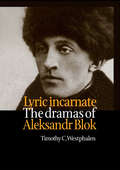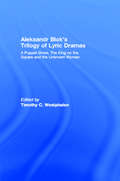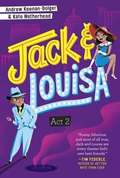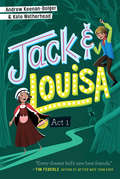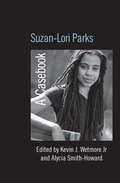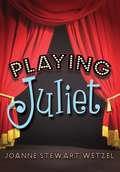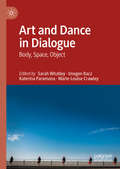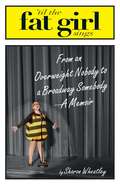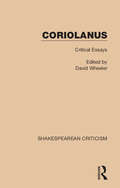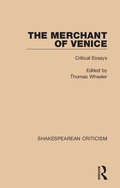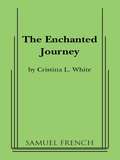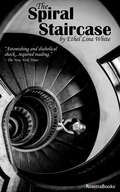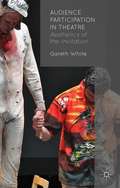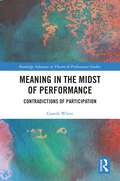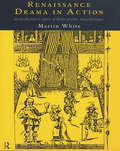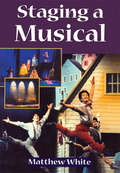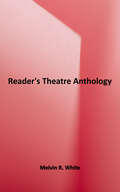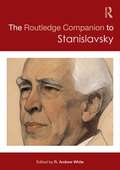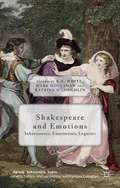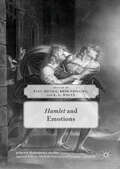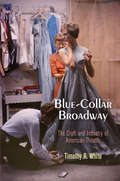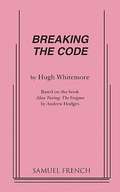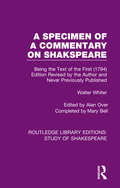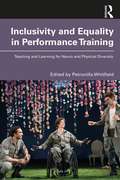- Table View
- List View
Lyric Incarnate: The dramas of Aleksandr Blok
by Timothy WestphalenLyric Incarnate examines the plays of Aleksandr Blok, the pre-eminent poet of Russian Symbolism and one of the greatest poets of the twentieth century. Blok's plays have received less attention than his poetry in the West, and this book is the first and only English-language monograph devoted to Blok the playwright. In chronological succession, each of Blok's major plays is examined in detail. Special attention is accorded to Blok's relations with the major directors of his time, particularly Meyerhold and Stanislavsky. Blok's role, for instance, in Meyerhold's formulation of the theatre of the grotesque proved to be critical, and his relation to the Moscow Art Theatre just before the October Revolution helped to define the future course of that theatre. Blok's innovative dramatic technique is carefully studied at each stage in his career, from his earliest "lyric dramas" , such as A Puppet Show and The Stranger, to his great tragedy The Rose and the Cross.
Aleksandr Blok's Trilogy of Lyric Dramas: A Puppet Show, The King on the Square and the Unknown Woman (Routledge Harwood Russian Theatre Archive Ser.)
by Timothy C. WestphalenAleksandr Blok's Trilogy of Lyric Dramas gathers together for the first time in English translation the first three plays by Aleksandr Blok, the pre-eminent poet of Russian Symbolism and one of the greatest poets of the twentieth century. The three plays that constitute the trilogy - A Puppet Show, The King on the Square and The Unknown Woman - are pivotal documents in the development of modernist drama. In his productions of A Puppet Show; and The Unknown Woman, Meyerhold first began to work the basic tenets of his approach to grotesque and constructivist theatre. Moreover, A Puppet Show provided the inspiration and much of the foundation for Meyerhold's theoretical writings. As a result, these plays are indispensable to any student of Meyerhold or modernist theatre. The plays are presented in the context of the poetry from which they issued in order to suggest how Blok developed the themes and motifs of the plays in other genres.
Jack & Louisa: Act 2
by Kate Wetherhead Andrew Keenan-BolgerA show-stopping series about life in the spotlight from Broadway actors and internet sensations Andrew Keenan-Bolger and Kate Wetherhead Shaker Heights Middle School is putting on Guys and Dolls and best friends Jack and Lou are hoping to get lead roles. But a mysterious new director soon arrives to town and threatens to meddle with their dreams. Is Shaker Heights big enough for two Broadway legends? Fans of Tim Federle's Better Nate Than Ever will rejoice to meet Jack & Lou--the newest MTN's (musical theater nerds) on the block.
Jack & Louisa: Act 1 (Jack & Louisa #1)
by Kate Wetherhead Andrew Keenan-BolgerTwelve-year old Jack Goodrich was a Broadway star, with two shows under his belt and a third in rehearsals. But when his voice changes suddenly, Jack and his parents leave the spotlight and move from New York City to Shaker Heights, Ohio. While Jack hopes to leave his Broadway past behind, his new neighbor refuses to let him off the hook. Louisa is a self proclaimed "musical theater nerd" and can hardly believe when an actor moves to town. What's more, the local theater has announced auditions for her favorite show, "Into the Woods." As the audition date looms nearer, the two are faced with difficult choices. Should Jack risk humiliation and return to the stage? Will Louisa have confidence to go it alone? And can their friendship survive all those complicated octave leaps?
Suzan-Lori Parks: A Casebook (Casebooks on Modern Dramatists)
by Kevin J. Wetmore Jr Alycia Smith-HowardSuzan-Lori Parks confirmed herself as one of the most exciting and successful playwrights of her generation when her work Topdog/Underdog was awarded the 2002 Pulitzer Prize, making her the only African American woman to win the award. Despite the cultural weight of this achievement, Parks remains difficult both to pigeonhole and to summarize. This volume seeks to provide a context for her work, with essays from major and emerging scholars addressing the importance of factors such as gender, ethnicity, language and history in plays from her first major work, Imperceptible Mutabilities of the Third Kingdom to the 365 Days / 365 Plays project. Suzan-Lori Parks: A Casebook represents the first major study of this unique voice in contemporary drama. Contributors: Leonard Berkman, Jason Bush, Shawn Marie-Garrett, Andrea Goto, Heidi Holder, Barbara Ozieblo, Kevin J. Wetmore Jr and Harvey Young. Kevin J. Wetmore Jr is Professor of Theatre at Loyola Marymount University, as well as being a professional actor and director of the Comparative Drama Conference. He is the author of The Athenian Sun in an African Sky and Black Dionysus: Greek Tragedy and African American Theatre. Alycia Smith-Howard an Assistant Professor at New York University in the Gallatin School of Individualized Study, where she is the Artistic Director of the Gallatin Arts Festival and the Book Reviews Editor at the New England Theatre Journal. A Fellow of the Folger Shakespeare Library, her areas of specialization include Shakespeare, performance history, feminist theatre aesthetics and literature and drama of the south.
Playing Juliet
by Joanne Stewart WetzelBeth Sondquist, age twelve and a half, dreams of playing the part of Juliet. For now she’s just the cat in Cinderella, but one day, she’s determined to become a real actress. But all her hopes for an acting career come crashing down when the Oakfield Children’s Theater is slated to be closed. Its new owner has decided to make it into an adult theater, a real theater. Beth and her best friend, Zandy, are willing to do whatever it takes to save the theater, but their plans quickly go awry. When Beth’s father catches her sneaking back into her bedroom window well past bedtime, Beth is in big, big trouble. With eviction looming, the children’s theater director decides to close the theater with the same play the theater opened with fifty years ago--Romeo and Juliet. But Beth’s grounded for the next two weeks, and she won’t be able to try out. How will Beth pull off playing Juliet if she can’t even make tryouts? Playing Juliet is funny and honest and celebrates bravery and doing the right thing even when it gets you into trouble. It’s about having the courage to go after what you want and making your dreams come true. It’s also about friendship and family. As an almost-thirteen-year-old, Beth has a unique bond with thirteen-year-old Juliet, and she eventually recognizes just how silly and immature Juliet’s decisions are. Only Beth can play Juliet as the kid that she is. With a little bit of luck, maybe she’ll get her chance.
Art and Dance in Dialogue: Body, Space, Object
by Sarah Whatley Imogen Racz Katerina Paramana Marie-Louise CrawleyThis interdisciplinary book brings together essays that consider how the body enacts social and cultural rituals in relation to objects, spaces, and the everyday, and how these are questioned, explored, and problematised through, and translated into dance, art, and performance. The chapters are written by significant artists and scholars and consider practices from various locations, including Central and Western Europe, Mexico, and the United States. The authors build on dialogues between, for example, philosophy and museum studies, and memory studies and post-humanism, and engage with a wide range of theory from phenomenology to relational aesthetics to New Materialism. Thus this book represents a unique collection that together considers the continuum between everyday and cultural life, and how rituals and memories are inscribed onto our being. It will be of interest to scholars and practitioners, students and teachers, and particularly those who are curious about the intersections between arts disciplines.
Til The Fat Girl Sings: From an Overweight Nobody to a Broadway Somebody-A Memoir
by Sharon WheatleyA Simon & Schuster eBook. Simon & Schuster has a great book for every reader.
Coriolanus: Critical Essays (Shakespearean Criticism)
by David WheelerOriginally published in 1995. Providing the most influential historical criticism, but also some contemporary pieces written for the volume, this collection includes the most essential study and reviews of this tragic play. The first part contains critical articles arranged chronologically while the second part presents reviews of stage performances from 1901 to 1988 from a variety of sources. Chapters chosen are representative of their given age and critical approach and therefore show the changing responses and the topics that interested critics in the play through the years. Coriolanus is an unsympathetic character and the play has been traditionally less popular than other tragedies - a comprehensive introduction by the editor discusses these attitudes to the play and the reasons behind them.
The Merchant of Venice: Critical Essays (Shakespearean Criticism)
by Thomas WheelerOriginally published in 1991. Essays here are arranged chronologically within sections: ‘The Play as Text’, ‘Shylock’ and ‘The Play in the Theatre.’ Collecting previously published important commentaries and scholarly articles, this volume in the Shakespearean Criticism set looks at one of the Bard’s most disturbing plays. These historical critical pieces give witness to the changing attitudes to the play and the characters and provide readers with a wide range of material relating both to performances and to textual readings.
Performing Orthodox Ritual in Byzantium
by Andrew Walker WhiteIn this groundbreaking, interdisciplinary study, Andrew Walker White explores the origins of Byzantine ritual - the rites of the early Greek Orthodox Church - and its unique relationship with traditional theatre. Tracing the secularization of pagan theatre, the rise of rhetoric as an alternative to acting, as well as the transmission of ancient methods of musical composition into the Byzantine era, White demonstrates how Christian ritual was in effect a post-theatrical performing art, created by intellectuals who were fully aware of traditional theatre but who endeavoured to avoid it. The book explores how Orthodox rites avoid the aesthetic appreciation associated with secular art, and conducts an in-depth study (and reconstruction) of the late Byzantine Service of the Furnace. Often treated as a liturgical drama, White translates and delineates the features of five extant versions, to show how and why it generated widely diverse audience reactions in both medieval times and our own.
Enchanted Journey
by Cristina L. WhiteTYA, Children's Theatre \ 4m, 4f \ Simple Set \ A prediction warning Prince Gustav of giants, witches, and danger does not prevent him from traveling to the faraway Kingdom of Lira when he learns his help is needed. He begins a journey which is indeed enchanted, for in the midst of danger he finds unexpected friendship and laughter. Before he reaches Lira, Gustav meets two witches, whose charm makes them unlike any ever encountered, and befriends a coward named Alakazam who travels with him to the dark garden of Gothar the Giant. The journey ends when the surprising and secret ambition of Gothar is learned, and Alakazam achieves his deepest wish through an act of courage.
The Spiral Staircase
by Ethel White"Adept at laying one icy finger on the back of your neck" - SpectatorHelen Capel is hired as a live-in lady-help to the Warren family in the countryside. She enjoys the eccentric household and her duties, but her peaceful and simple life is soon disturbed by a series of mysterious murders in the isolated community.As Helen's employer, Professor Sebastian Warren, battens down the hatches and locks all the doors of their remote country house, the eight residents begin to feel safe. But somewhere out there lurks a murderer of young girls. As the murders crawl closer to home, Helen starts to wonder if there really is safety in numbers--and what happens when those numbers start to dwindle?
Audience Participation in Theatre
by Gareth WhiteThis book asks that we consider the practices that facilitate audience participation on equal terms with other elements of the theatre maker's art; it offers a theoretical basis for this new approach, illustrated by examples from diverse participatory performances.
Meaning in the Midst of Performance: Contradictions of Participation (Routledge Advances in Theatre & Performance Studies)
by Gareth WhiteBeing an audience participant can be a confusing and contradictory experience. When a performance requires us to do things, we are put in the situation of being both actor and spectator, of being part of the work of art while also being the audience who receives it, and of being both perceiving subject and aesthetic object. This book examines these contradictions – and many others – as they appear by accident and by design in increasingly popular forms of interactive, immersive, and participatory performance in theatre and live art. Borrowing concepts from cognitive philosophy and bringing them into a conversation with critical theory, Gareth White sharply examines meaning as a process that happens to us as we are engaged in the problems and negotiations of a participatory performance. This study will be of great interest to scholars and students of theatre and performance, intermedial arts and games studies, and to practising artists.
Renaissance Drama in Action: An Introduction To Aspects Of Theatre Practice And Performance
by Martin WhiteRenaissance Drama in Action is a fascinating exploration of Renaissance theatre practice and staging. Covering questions of contemporary playhouse design, verse and language, staging and rehearsal practices, and acting styles, Martin White relates the characteristics of Renaissance theatre to the issues involved in staging the plays today. This refreshingly accessible volume: * examines the history of the plays on the English stage from the seventeenth century to the present day * explores questions arising from reconstructions, with particular reference to the new Globe Theatre * includes interviews with, and draws on the work and experience of modern theatre practitioners including Harriet Walter, Matthew Warchus, Trevor Nunn, Stephen Jeffreys, Adrian Noble and Helen Mirren * includes discussions of familiar plays such as The Duchess of Malfi and 'Tis Pity She's A Whore, as well as many lesser known play-texts Renaissance Drama in Action offers undergraduates and A-level students an invaluable guide to the characteristics of Elizabethan and Jacobean drama, and its relationship to contemporary theatre and staging.
Staging A Musical: An Essential Guide (Stage And Costume Ser.)
by Matthew WhiteIn Staging a Musical, Matthew White describes all the elements involved in putting on a musical production, including: how to choose the right show, budgets and schedules, auditions, rehearsals, and performances.
Mel White's Readers Theatre Anthology
by Melvin R. WhiteThe growing popularity of Readers Theatre proves you don't need scenery or costumes to create a stirring dramatic performance. This collection of scripts by a nationally known authority on the subject will add a new theatrical look to your drama program. Their ease of performance makes these scripts ideal for classroom use, as well. A variety of stories from the pens of classical and contemporary writers, journalists, and playwrights, all adapted to reader’s theatre performance, make this text a truly valuable part of any drama library. The material includes comedy, mystery and suspense, Christmas stories, folklore, and children's classics. Classic and contemporary works by William Shakespeare, James Thurber, Rudyard Kipling, O. Henry, Gordon Bennett, and many more are included.
The Routledge Companion to Stanislavsky (Routledge Companions Ser.)
by R. Andrew WhiteStanislavsky’s system of actor-training has revolutionised modern theatre practice, and he is widely recognised to be one of the great cultural innovators of the twentieth century. The Routledge Companion to Stanislavsky is an essential book for students and scholars alike, providing the first overview of the field for the 21st century. An important feature of this book is the balance between Stanislavsky’s theory and practice, as international contributors present scholarly and artistic interpretations of his work. With chapters including academic essays and personal narratives, the Companion is divided into four clear parts, exploring Stanislavsky on stage, as an acting teacher, as a theorist and finally as a theatre practitioner. Bringing together a dazzling selection of original scholarship, notable contributions include:Anatoly Smeliansky on Stanislavsky’s lettersWilliam D. Gunn on staging ideology at the Moscow Art TheatreSharon Marie Carnicke and David Rosen on opera Rosemary Malague on the feminist perspective of new translationsW.B. Worthen on cognitive scienceJulia Listengarten on the avant-gardeDavid Krasner on the System in America and Dennis Beck on Stanislavsky’s legacy in non-realistic theatre R. Andrew White is Associate Professor of Theatre at Valparaiso University, where he annually directs productions. He has an MFA in Acting from Carnegie Mellon University and the Moscow Art Theatre School, and has worked as an actor at a variety of theatres in the United States. In addition, his scholarship has appeared in edited works published by Routledge and Palgrave Macmillan, as well as in top American journals including Theatre Survey, TDR/The Drama Review, and New England Theatre Journal.
Shakespeare and Emotions
by R. S. White Mark Houlahan Katrina O’loughlinThis collection of original essays by established and emerging scholars approaches the works of Shakespeare from the topical perspective of the History of Emotions. What emerges is not a single paradigm or 'grand narrative', but a variety of approaches, ranging from the historical to the interpretive, illuminating the primacy of emotions in Shakespearean scholarship and theatre. The section 'Emotional Inheritances' looks back to Shakespeare's sources and cultural backgrounds, showing that some aspects of his representations of emotions come from the classics and medieval world; 'Shakespearean Enactments' presents essays that analyse a range of emotional states and issues in the plays themselves; while 'Legacies and Re-Enactments' traces aspects of his influence through later times and down to the present day. Taken together these diverse but related essays present a kaleidoscope of suggestive approaches to the potentially endless subject of emotions in Shakespeare.
Hamlet and Emotions (Palgrave Shakespeare Studies)
by R. S. White Paul Megna Bríd PhillipsThis volume bears potent testimony, not only to the dense complexity of Hamlet’s emotional dynamics, but also to the enduring fascination that audiences, adaptors, and academics have with what may well be Shakespeare’s moodiest play. Its chapters explore emotion in Hamlet, as well as the myriad emotions surrounding Hamlet’s debts to the medieval past, its relationship to the cultural milieu in which it was produced, its celebrated performance history, and its profound impact beyond the early modern era. Its component chapters are not unified by a single methodological approach. Some deal with a single emotion in Hamlet, while others analyse the emotional trajectory of a single character, and still others focus on a given emotional expression (e.g., sighing or crying). Some bring modern methodologies for studying emotion to bear on Hamlet, others explore how Hamlet anticipates modern discourses on emotion, and still others ask how Hamlet itself can complicate and contribute to our current understanding of emotion.
Blue-Collar Broadway
by Timothy R. WhiteBehind the scenes of New York City's Great White Way, virtuosos of stagecraft have built the scenery, costumes, lights, and other components of theatrical productions for more than a hundred years. But like a good magician who refuses to reveal secrets, they have left few clues about their work. Blue-Collar Broadway recovers the history of those people and the neighborhood in which their undersung labor occurred.Timothy R. White begins his history of the theater industry with the dispersed pre-Broadway era, when components such as costumes, lights, and scenery were built and stored nationwide. Subsequently, the majority of backstage operations and storage were consolidated in New York City during what is now known as the golden age of musical theater. Toward the latter half of the twentieth century, decentralization and deindustrialization brought the emergence of nationally distributed regional theaters and performing arts centers. The resulting collapse of New York's theater craft economy rocked the theater district, leaving abandoned buildings and criminal activity in place of studios and workshops. But new technologies ushered in a new age of tourism and business for the area. The Broadway we know today is a global destination and a glittering showroom for vetted products.Featuring case studies of iconic productions such as Oklahoma! (1943) and Evita (1979), and an exploration of the craftwork of radio, television, and film production around Times Square, Blue-Collar Broadway tells a rich story of the history of craft and industry in American theater nationwide. In addition, White examines the role of theater in urban deindustrialization and in the revival of downtowns throughout the Sunbelt.
Breaking the Code
by Hugh WhitemoreDerek Jacobi took London and Broadway by storm in this exceptional biographical drama about a man who broke too many codes: the eccentric genius Alan Turing who played a major role in winning the World War II; he broke the complex German code called Enigma, enabling allied forces to foresee German maneuvers. Since his work was classified top secret for years after the war, no one knew how much was owed to him when he was put on trial for breaking another code the tab.
A Specimen of a Commentary on Shakspeare: Being the Text of the First (1794) Edition Revised by the Author and Never Previously Published (Routledge Library Editions: Study of Shakespeare)
by Walter WhiterIf it is not generally known that the foundations of twentieth-century criticism of Shakespeare’s imagery were laid over one hundred and fifty years ago, the explanation lies in the limited availability of the single original edition of Walter Whiter’s Specimen of a Commentary on Shakspeare published in 1794. In an age in which the study of Shakespeare’s characters was of prime interest and importance, Whiter – a classical scholar who took holy orders and ended his life as a country parson – developed a form of textual criticism closely linked to a study of the workings of the human mind: and his book offers a psychological survey of the creative imagination, following the principles laid down in Locke’s Essay on Human Understanding and illustrated by examples from Shakespeare’s plays. In his realization that Shakespeare provides the finest examples of the poetic imagination Whiter is of his time: but in his particular study of the associative powers of such a mind engaged in the process of creation, he is far in advance of his time and has no immediate disciples in the later nineteenth century. In the twentieth century, however, there was an increasing acknowledgement of Whiter’s work and a more frequent appeal for the reissue of his book. Originally published in 1967, the present edition was started in response to that appeal more than ten years before Mr Alan Over’s tragic death in 1964 and incorporates the revisions and additions made by Whiter for his own projected second edition.
Inclusivity and Equality in Performance Training: Teaching and Learning for Neuro and Physical Diversity
by Petronilla WhitfieldInclusivity and Equality in Performance Training focuses on neuro and physical difference and dis/ability in the teaching of performance and associated studies. It offers 19 practitioners’ research-based teaching strategies, aimed to enhance equality of opportunity and individual abilities in performance education. Challenging ableist models of teaching, the 16 chapters address the barriers that can undermine those with dis/ability or difference, highlighting how equality of opportunity can increase innovation and enrich the creative work. Key features include: Descriptions of teaching interventions, research, and exploratory practice to identify and support the needs and abilities of the individual with dis/ability or difference Experiences of practitioners working with professional actors with dis/ability or difference, with a dissemination of methods to enable the actors A critical analysis of pedagogy in performance training environments; how neuro and physical diversity are positioned within the cultural contexts and practices Equitable teaching and learning practices for individuals in a variety of areas, such as: dyslexia, dyspraxia, visual or hearing impairment, learning and physical dis/abilities, wheelchair users, aphantasia, attention-deficit/hyperactivity disorder and autistic spectrum. The chapter contents originate from practitioners in the UK, USA and Australia working in actor training conservatoires, drama university courses, youth training groups and professional performance, encompassing a range of specialist fields, such as voice, movement, acting, Shakespeare, digital technology, contemporary live art and creative writing. Inclusivity and Equality in Performance Training is a vital resource for teachers, directors, performers, researchers and students who have an interest in investigatory practice towards developing emancipatory pedagogies within performance education.
